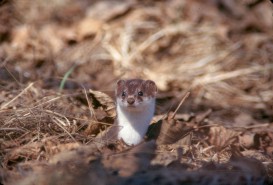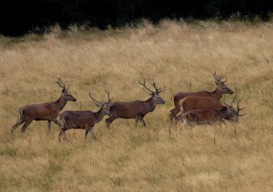Góry Stołowe - kraina zrodzona z morza
 Animal life
Animal life
Mammals
So far, 48 species of mammals have been detected in the area of the Stołowe Mountains National Park. This list is probably not complete yet. Such mammals as hedgehog, mole, roe deer, squirrel, and some species of mice and voles, common shrew, etc. are very common throughout the country, so there is no surprise to find them here as well. Alpine species are not found here due to the lack of the alpine belt in the Stołowe Mountains. Among the mammals that are typical to mountains areas, only the alpine shrew occurs here, which is slightly bigger than the widespread common shrew. It usually lives at elevations more than 500 m above
 see level. The species feeds on invertebrates which it usually hunts in the wet environments. Between May and October, the female has 1 - 2 litters a year, containing about 6 young. The presence of the black variety of squirrel underlines a mountainous character of the region. It is found twice often in the mountains forests than the red squirrel, and it is much rarer in Kudowa Zdrój, for example. Night is a good time to meet many interesting mammals. Then, the mammals are more sure that they avoid contacts with a human. In the beech forest, we can come into the fat dormouse, which is often mistaken for the grey squirrel because of the bushy tail. However, there are no closer relations between the two. It is very agile among the trees, jumping from branch to branch high above the ground in search of the beech seeds.
see level. The species feeds on invertebrates which it usually hunts in the wet environments. Between May and October, the female has 1 - 2 litters a year, containing about 6 young. The presence of the black variety of squirrel underlines a mountainous character of the region. It is found twice often in the mountains forests than the red squirrel, and it is much rarer in Kudowa Zdrój, for example. Night is a good time to meet many interesting mammals. Then, the mammals are more sure that they avoid contacts with a human. In the beech forest, we can come into the fat dormouse, which is often mistaken for the grey squirrel because of the bushy tail. However, there are no closer relations between the two. It is very agile among the trees, jumping from branch to branch high above the ground in search of the beech seeds.
In autumn, it is sometimes seen within human households, and it hibernates hidden under the ground during the wintertime. Two of its relatives can be found in the Park. The common dormouse which is much smaller, often occupies the breeding boxes after it rebuilds the existing bird's nest into a some kind of igloo. It is the most common species of the arboreal rodents. The forest dormouse, the rarest of them, is found here in stands that are farthest west within the whole area of its occurrence. In Poland, it was detected in areas of more severe climate, mostly in the mountains and in the northeast. Although it is a nocturnal animal, the forest dormouse is also active in daytime during autumn in order to build up enough fat for winter. Its food mainly includes insects. It also feeds on fruits and seeds. It sets up its nest in a bird's nest or hollow. In wintertime, the above-mentioned three species usually set up their lair under ground, where the temperature is more stable and they can sleep during this unfavourable period. They may complete their diet by robbing birds' nests, but this does not cause much harm. The fat dormouse, for example, hibernates during as many as seven months a year. It is not very surprising that there exist two stands of the otter, since this mammal has spread very widely in the recent years. Unfortunately, the streams in the Park are not large enough to provide the optimum conditions for dwelling (feeding), therefore the occurrences relate to lower mountain parts along the Park's borders. The otter mainly feed on fish, and its excrements left in upper spots are filled with fish odour. This acts as information for other individuals of the species - here is my district. The otter leads a nocturnal way of life, therefore we must be lucky to spot it. During past few years, some single observations of the bear, wolf and chamois were conducted. The presence of the bear was not fully confirmed but the trails of one individual, found in the years of 1991 - 98, let us assume that it visited these areas. Unfortunately, in that case it was only a single individual that has no chance for reproduction. The wolf was seen in the Stołowe Mountains in spring 2000, after the long period of absence. Due to the small size of the mountains and large penetration, there is little hope for the wolf to settle down here. Nevertheless, it could find here considerable resources in the form of excessively large deer population. The chamois was spotted here in 1996, however it was not a natural newcomer. Probably, it was an individual coming from the herd introduced at the beginning of the seventies in Śnieżnik Kłodzki region. The area is also visited by the mouflon which does not consider the Stolowe Mountains as their refuge. The fallow deer is also found here very rarely. The latter three species of mammals were introduced to the environment as a result of the game management by humans. Their presence is not desirable in the Park's area as they are analien element here. The vespertilio murinus, a species of bats that is included in the Polish Red Book of Animals, was confirmed in several stands within the farm buildings. Apart from it, there are 12 more species of bats, which often find shelter in rock crevices. Like with the birds, there are some interesting links, established between some mammals and sandstone rocks. Rock cliffs are the natural barrier for wandering mammals, along which plenty of trails are found. In the numerous, wide recesses, the deer and wild hog rub against the walls leaving trails of dried mud mixed with hairs. They also take a rest there. Most of the foxes do not dig their dens by themselves, instead they use natural rock labyrinths as their shelter, by only widening them a little. In the recent years, the first signs of synanthropization of this mammal were noticed; it feeds on wastes and approaches very close to the human. The badger also inhabits the existing rock corridors, only exceptionally digging a den. This mammal leads a nocturnal way of life, and we can sometimes see it feeding at the main Park's roads. It does not have any natural enemies, except the human, therefore it behaves very loudly while searching for food. Surprisingly, the squirrels are also found in this area, using rock recesses as their nesting laces. These nests slightly differ from typical nest structures, since they contain dry grass only. Finally, it is worth mentioning the deer due to its big population, and the role playing in biocoenoses in this area. In the rutting period, from September to October, loud roaring of the deer can be heard practically everywhere, e.g. at the Road of Hundreds Turns, in Karłów, at Stray Rocks, sometimes also at daylight. It is also not very rare to encounter the deer. In order to take a closer look at them, we advise going to Szczeliniec or Narożnik early in the morning or just after the sunset. Without going out of the trail, we can admire dozens of deer going to nearby meadows in search of food. The roe deer are also seen.
element here. The vespertilio murinus, a species of bats that is included in the Polish Red Book of Animals, was confirmed in several stands within the farm buildings. Apart from it, there are 12 more species of bats, which often find shelter in rock crevices. Like with the birds, there are some interesting links, established between some mammals and sandstone rocks. Rock cliffs are the natural barrier for wandering mammals, along which plenty of trails are found. In the numerous, wide recesses, the deer and wild hog rub against the walls leaving trails of dried mud mixed with hairs. They also take a rest there. Most of the foxes do not dig their dens by themselves, instead they use natural rock labyrinths as their shelter, by only widening them a little. In the recent years, the first signs of synanthropization of this mammal were noticed; it feeds on wastes and approaches very close to the human. The badger also inhabits the existing rock corridors, only exceptionally digging a den. This mammal leads a nocturnal way of life, and we can sometimes see it feeding at the main Park's roads. It does not have any natural enemies, except the human, therefore it behaves very loudly while searching for food. Surprisingly, the squirrels are also found in this area, using rock recesses as their nesting laces. These nests slightly differ from typical nest structures, since they contain dry grass only. Finally, it is worth mentioning the deer due to its big population, and the role playing in biocoenoses in this area. In the rutting period, from September to October, loud roaring of the deer can be heard practically everywhere, e.g. at the Road of Hundreds Turns, in Karłów, at Stray Rocks, sometimes also at daylight. It is also not very rare to encounter the deer. In order to take a closer look at them, we advise going to Szczeliniec or Narożnik early in the morning or just after the sunset. Without going out of the trail, we can admire dozens of deer going to nearby meadows in search of food. The roe deer are also seen.
Do you want to know more? Choose the topic
Park Narodowy Gór Stołowych
ul. Słoneczna 31
57-350 Kudowa Zdrój
tel. +48 74/ 8661-436, +48 74/ 8662-097
fax. +48 74/ 8654-918
pngs@pngs.com.pl
Copyright by Park Narodowy Gór Stołowych
